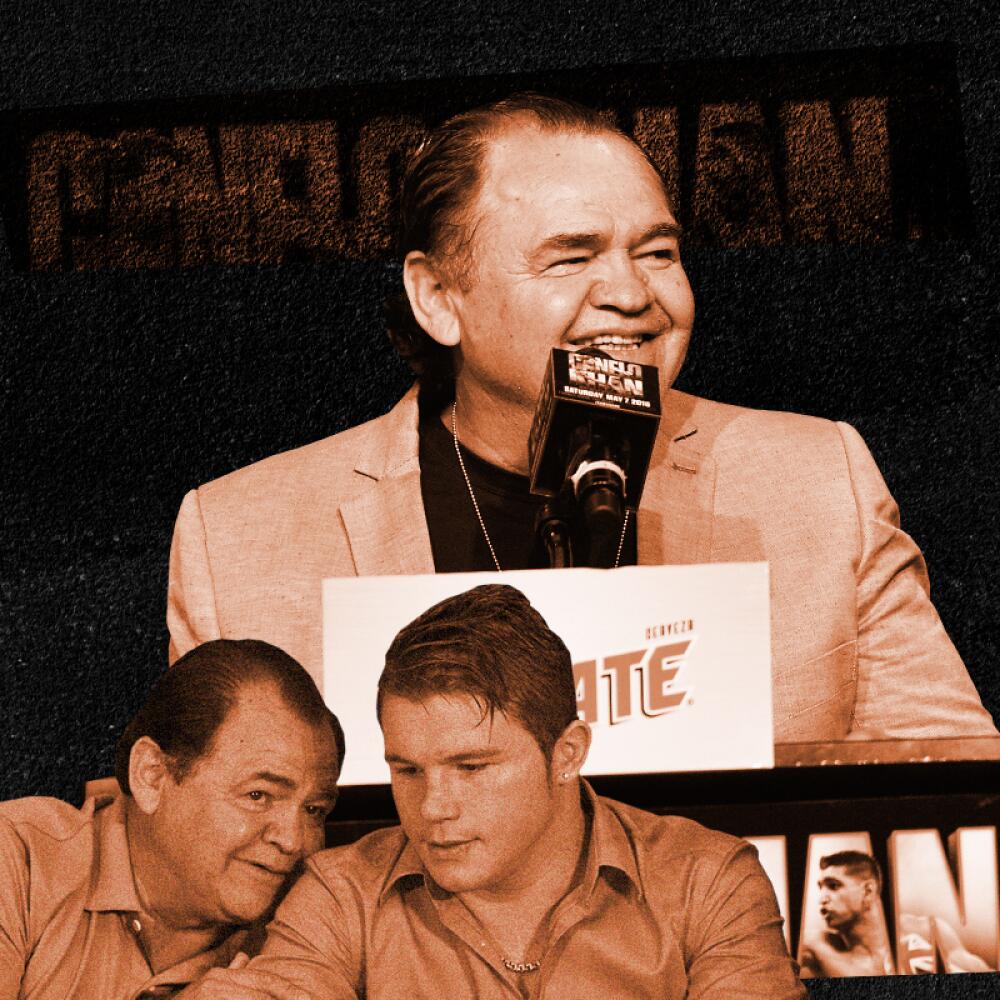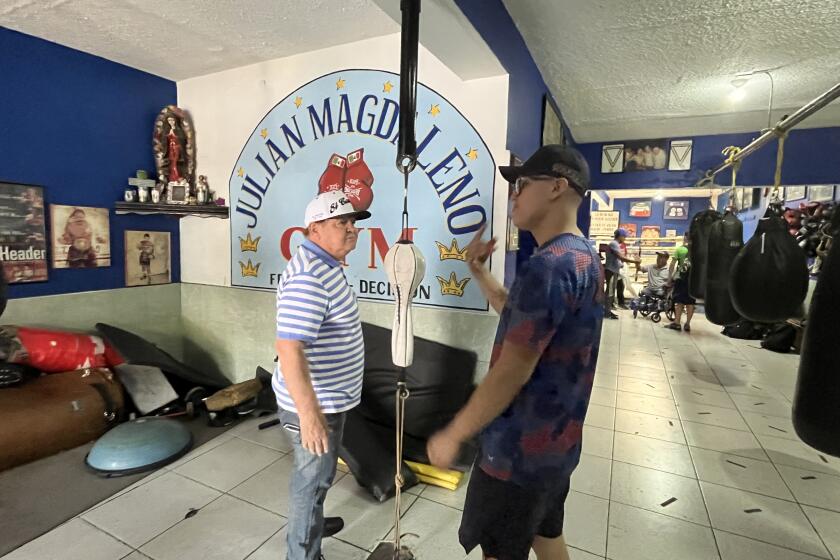
- Share via
Situated in a nondescript neighborhood of Guadalajara’s Antigua Penal neighborhood, Gimnasio Julián Magdaleno doesn’t look like much from the outside.
Inside at the end of a long hallway is an old boxing ring, and in one corner a small altar to the Virgen de Guadalupe with photos of Oscar “Chololo” Larios, the first champion trained by Don Chepo Reynoso decades ago.
At 70 years old, Don Chepo, doesn’t stop moving. His son Eddy Reynoso is Saúl “Canelo” Alvarez’s current trainer, but it was Don Chepo that put the Mexican champion on the path to greatness over two decades ago. When Canelo, accompanied by his brother Rigoberto, showed up as a 14-year-old to begin training, Don Chepo already had two champions in his fold, Lario and Javier “Chatito” Jáuregui.
A sus 70 años, Don Chepo Reynoso busca nuevos talentos, a pesar de que hace dos décadas forjó a uno de los mejores campeones mexicanos en la historia; Rigoberto, hermano mayor de Canelo, también quiere fabricar sus propios monarcas del mundo
Don Chepo doesn’t spend as much time with Canelo as he used to after a doctor’s recommendation to take things easy to focus on his high blood pressure. It wasn’t just doctors who told him to relax. Canelo and Eddy Reynoso both advised the veteran trainer to spend more time with his grandchildren and avoid the hectic schedule that is required of training one of the elite boxers in the world.
Currently, Don Chepo works about four hours a day with his boxers, managing their sparring schedule and functioning more as an advisor.
Canelo credits Don Chepo and Eddy Reynoso for launching his career, resulting in multiple world championships in four weight classes.
“It was in that gym where I became a boxer. It was where I learned my first lessons,” said Canelo.

The gym opened in 2004 under the banner of “Fé, ilusión y decisión” and those three words are still recorded in faded paint on its walls. The name of the gym, Julián Magdaleno, is in honor of one of Don Chepo’s teachers and someone he credits with showing him all he knows about the sweet science.
Magdaleno, who died in 1988, trained multiple Mexican boxers and was in the corner of Alejandro “Cobrita” González when he beat Kevin Kelly to win the World Boxing Council’s featherweight title in 1995. He also helped in the early phases of training Larios, who continued his work with Don Chepo leading to a title belt.
While the walls of the gym have started to show signs of age, they hold up some key pieces in the history of Canelo, including the gloves he used in fights against Joseito López in 2012 and Floyd Mayweather Jr. in 2013.
When Canelo arrived as a young man he wasn’t an unknown to Don Chepo and Eddy, who had seen him fight in the junior ranks. Even though Canelo had shown great promise from a young age, the Reynosos never gave him special treatment and instilled a work ethic that has carried the fighter to this day.

It was the first formal training Canelo ever received. His brother Rigoberto showed him how to throw punches from the porch of their home. From the start, Canelo was always a strong fighter who went forward. Rigoberto would take Canelo out to run and showed him how to be disciplined with his training. But it quickly became apparent to Rigoberto that Canelo needed something more. Enter the Reynosos.
“They completely remade me, I used to only want to throw punches, but they taught me how to move my hips, avoid punches and to counterpunch,” said Canelo. “It’s important to avoid getting hit. In boxing it is important to hit someone as much as you can and to avoid getting hit as much as you can.”
Don Chepo slowly started building a champion, imparting what he had learned from Magdaleno, and also Jesús “Cholaín” Rivero, who was Oscar de la Hoya’s trainer for many years.
Canelo was a quick study. He won the silver medal in the Junior Olympics and later won the Mexican national championship in his age group. His most difficult loss came against Mario Cázarez in the gold medal fight in the Junior Olympics. Canelo was in tears after suffering his first loss as an amateur.
But the Julián Magdaleno gym also showed him how to lose.
At the end of the long hallway, on one of the walls facing the ring there is sign that has been up since the gym was founded: “Lo peor que te puede pasar es que te valga madre perder”.
Both Canelo Alvarez and Terrence Crawford have done enough to put themselves in a class by themselves in modern boxing.
Since the first moments of Canelo’s training until now that message has become one of Don Chepo’s mantras.
“For those that don’t care about losing then the door is open for you to leave because I don’t want you contaminating the others,” insisted Don Chepo. “If you don’t care about losing in life then you are a dead man walking who doesn’t have any dreams.”
Canelo learned that lesson and has applied it to his life. After his loss he went undefeated through the amateur ranks and didn’t suffer another defeat until he faced Mayweather in 2013.
“When you lose you have to accept it, but you have to keep working so it doesn’t happen again,” said Canelo
Today, Don Chepo wakes at 7 a.m. and gets on the stationary bike. His knees don’t allow him to go to the park and jog anymore. He takes a bath, has breakfast and arrives at the gym at around 9. He trains his young fighters on things bigger than boxing and in keeping with his philosophy he uses lessons picked up in the ring in real life.
“El que entrena a medias se hace pend … entero”, he yells at his young fighters. Don Chepo fought in the Golden Gloves in 1969 but didn’t turn pro because his career as butcher was more lucrative than boxing.
Canelo doesn’t forget about his former trainer. On his birthday, which falls on May 6, a date usually reserved for Canelo’s fights, the Mexican champion makes a point of reaching out to his mentor. This year, Don Chepo’s birthday fell on the same day as Canelo’s fight against John Ryder in Guadalajara. Canelo sang him “Las Mañanitas” before entering the ring.
“That day he called me early to wish me a happy birthday. When he celebrates his birthday, I do the same,” said Don Chepo.
Canelo, the highest paid fighter in boxing, will next fight on Sept. 30 against Jermell Charlo in Las Vegas in a defense of his super middleweight belt.
Currently, Don Chepo has several fighters under his tutelage. But while he focuses on getting them to commit to his basic principles that are required of his fighters — discipline, valor and a strong punch — he also ensures that he helps them avoid the pitfalls outside the gym.
“There are times I ask fighters why I don’t see them come around the gym anymore, but later I see they have to take care of a new child,” said Don Chepo. “For some it’s not their moment.”
His main focus lately has been on two talented young fighters in Iván Ortiz and Canelo’s nephew, Johan Alvarez, 19, whose last fight was on the same card as his uncle on May 5 in Guadalajara. Johan Alvarez is an up-and-coming fighter who has six wins and one draw, but his career trajectory is dependent on his discipline, according to Don Chepo.
“If he wants to reach the top he has to start from the bottom,” said Don Chepo about Johan Alverez’s chances of becoming a champion.
Don Chepo feels a great sense of responsibility because many of his young fighters dream of becoming the next Canelo Alvarez. But Don Chepo knows there is only one Canelo.
“There will only ever be one Canelo. Like there is only one Julio César Chávez, one Mantequilla Nápoles,” affirmed Don Chepo. “Canelo is like Fernando Valenzuela in baseball. Thanks to Fernando Valenzuela, everyone wanted to play baseball and he made baseball popular in Mexico.”
Reynoso acknowledged that only a few of his fighters will ever become professionals, but he will not ignore those that will never make a living inside of the ring.
“Hopefully they will become good fighters, but hopefully they will become better people,” said Don Chepo.
More to Read
The Latinx experience chronicled
Get the Latinx Files newsletter for stories that capture the multitudes within our communities.
You may occasionally receive promotional content from the Los Angeles Times.










